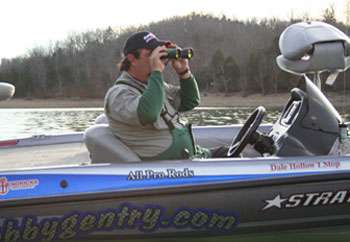
Sometimes the difference between fishing and catching comes down to information — knowing what's going on around you and adapting to it.
"I think a lot of anglers pay too much attention to their tackle when they should be spending more time analyzing their surroundings," says longtime Dale Hollow Lake smallmouth guide Bobby Gentry (www.bobbygentry.com). "Now don't get me wrong, your equipment's important but so are other things. I want to know what's going on around me — what's happening on the lake."
Specifically, Gentry wants to know what the birds are doing up by the dam; what the opposite shoreline looks like; or maybe what type of rock is on that point way over there, off to the right. He also wants to know why there's a marker buoy in the middle of the lake, what a sign says or maybe what another boat is doing. Information matters.
To get that information efficiently he uses binoculars. "They're indispensable. They're like my life jacket. I wouldn't feel comfortable on the water without them."
But picking the right set of glasses isn't easy. Bassmaster.com asked Mike Salito of Alpen Optics (www.alpenoutdoor.com), for help. Here's what he had to say:
1. Waterproof. Obviously, any pair of glasses that'll be used on the water must be waterproof. Water resistant won't do the job.
2. Fogproof. Glasses should be useable immediately, not after the fog clears from the lens.
3. Know your numbers. A pair of binoculars rated 8 x 42 means the magnification power is 8 and the objective lens diameter is 42 mm. The higher the magnification the bigger the image will appear. The bigger the diameter of the objective lens, the more light will reach your eye.
Most anglers will want a magnification of 8 or 10 and an objective lens diameter of 42 mm or larger.
4. Understand what "exit pupil" is and why it's important. Exit pupil is a numerical measurement of how much light is useable by the binocular. It's determined by the magnification power divided into the objective lens diameter.
Most anglers will want a value between 4 and 5 for satisfactory performance under dim light conditions.
5. Field of view. The field of view is how much you can see through the lens. It's measured in feet per 1,000 yards. A standard field of view is usually sufficient for fishing.
6. Long eye relief. This feature will allow users with eyeglasses or sunglasses to use the binoculars without removing their glasses.
7. Multi-coated or phase coated lenses. This is important to anglers because multi or phase coated lenses give truer color and better definition.
8. Toughness. Choose a pair of glasses that are made tough and that carry a full warranty. On-water use is hard on glasses. They'll need to hold up.
Salito concludes with this specific recommendation, "One of our most popular models for anglers is the Alpen Pro W/Proof 387. We recommend them to anglers because they meet all of our on-water requirements and they're reasonably priced (around $140)."
A good pair of optics can help you see what you're otherwise missing on the water.




